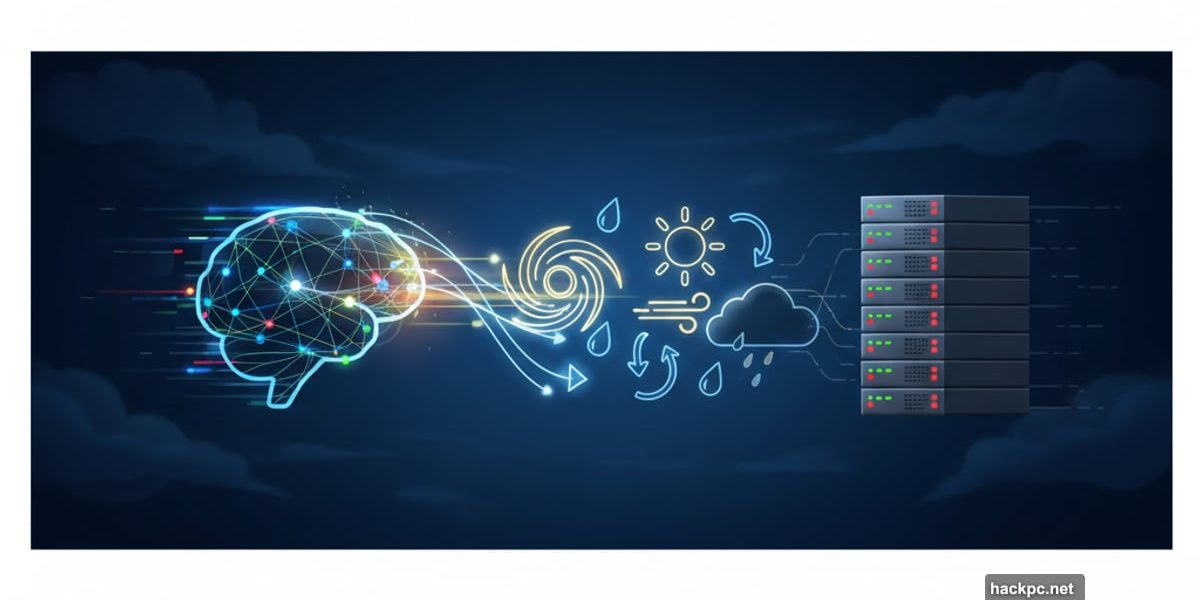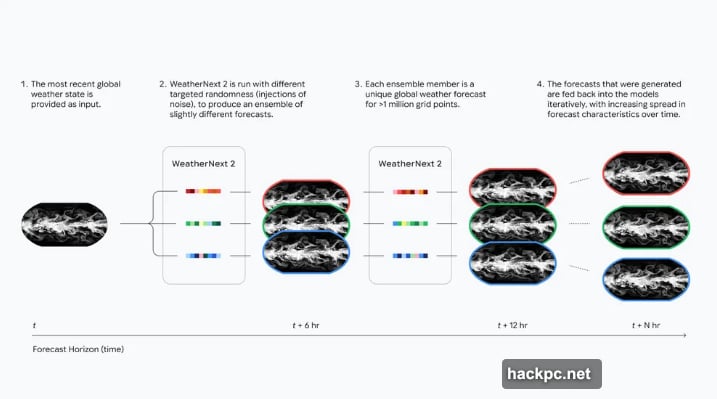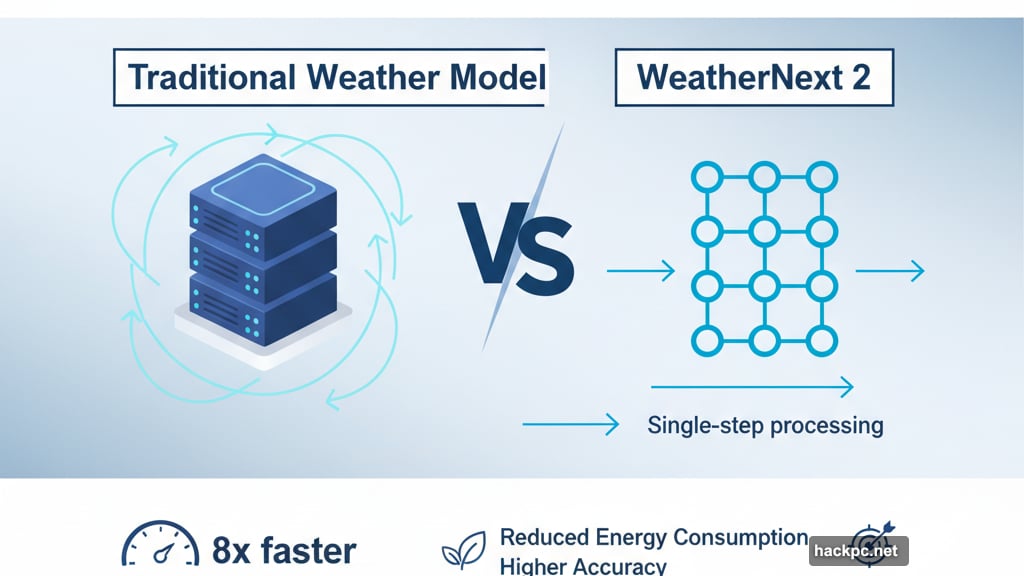
Weather forecasting got a serious upgrade. Google’s DeepMind just dropped WeatherNext 2, and it’s crushing traditional prediction methods.
The new AI model predicts weather up to two weeks ahead with better accuracy than before. Plus, it runs eight times faster than the previous version. That’s a big deal for anyone who needs precise weather data fast.
Hurricane Tracking Gets Three-Day Head Start
Tropical storms are notoriously hard to predict. Their paths shift constantly, making evacuation planning a nightmare.
WeatherNext 2 changes that equation. The model now predicts hurricane tracks accurately three days out. That’s a full day better than the previous version.
Think about what that extra day means. Emergency managers get more time to evacuate coastal areas. Businesses can protect assets sooner. Airlines can reroute flights before storms hit. One additional day of accurate warning saves lives and millions of dollars.
The improvement comes from better processing of atmospheric data. Traditional models struggle with the chaotic nature of tropical systems. But AI excels at finding patterns in messy, complex datasets.
Hourly Forecasts Change the Business Game

Most weather models update every few hours. That’s fine for planning your weekend. But it’s terrible for businesses that need minute-by-minute precision.
Enter hourly forecasts. WeatherNext 2 delivers updated predictions every 60 minutes with details on temperature, pressure, and wind conditions.
Energy traders are already excited. Wind and solar power generation depends heavily on weather conditions. An hourly forecast lets them predict power output more accurately. That means better trading decisions and less wasted energy.
Plus, logistics companies benefit enormously. Shipping routes, flight schedules, and delivery timing all hinge on weather. Hourly updates let them optimize operations continuously instead of planning around stale data.
Single-Step Processing Cuts Costs Dramatically
Here’s where things get technically interesting. Older AI weather models borrowed techniques from image and video generation.
Those methods required repeated processing cycles. The AI would make a prediction, check it, refine it, and repeat. That approach demanded expensive computing power and took forever.
WeatherNext 2 uses a completely different approach. It processes weather data in a single step. No repeated refinements needed.

The result? Much faster predictions that cost less to generate. Companies can run more forecasts more often without breaking their computing budgets.
This matters beyond just speed and cost. Faster processing means forecasters can test more scenarios. They can explore “what if” situations that help identify unlikely but dangerous weather events.
AI Struggles With Extreme Weather Events
No technology is perfect. WeatherNext 2 has a notable weakness: predicting outlier rain and snow events.
Why? Training data gaps. Extreme weather happens rarely by definition. So AI models don’t see enough examples during training to recognize those patterns reliably.
DeepMind researcher Ferran Alet acknowledged the limitation directly. “It’s one limitation of our forecast, but one that we are working on improving,” he told Bloomberg.
This creates a concerning scenario. AI excels at routine forecasting but struggles exactly when people need it most—during extreme events. That’s when traditional forecasting methods and human meteorologists remain crucial.
Still, the research team is actively addressing this gap. More training data and refined algorithms should improve extreme event prediction over time.

The Weather AI Arms Race Heats Up
Google isn’t alone in this space. Weather forecasting has become a battleground for AI companies.
NVIDIA built models for atmospheric simulation. Microsoft partnered with weather services for AI-powered forecasts. AccuWeather launched its own AI prediction system. Even Huawei jumped in with weather modeling tech.
Why the sudden rush? Weather data is massive business. Agriculture, energy, transportation, and insurance all depend on accurate forecasts. Better predictions mean billions in saved costs and improved efficiency.
Moreover, climate change makes weather more unpredictable. Traditional models based on historical patterns struggle when those patterns shift. AI adapts faster to changing conditions.
The competition benefits everyone. As companies race to build better models, forecast accuracy improves across the board. That means better planning for businesses and safer conditions for people.
What This Means for Regular People
You might wonder how AI weather models affect your daily life. The answer: more than you think.
Your weather app probably already uses some form of AI forecasting. These improved models will make those apps more accurate. That means better decisions about whether to bring an umbrella or reschedule outdoor plans.

But the real impact runs deeper. Better weather forecasts improve food supply chains, keeping grocery costs lower. They help utilities manage power grids more efficiently, potentially reducing energy bills. They even help cities plan road maintenance and snow removal better.
Plus, accurate long-range forecasts let you plan vacations and outdoor events with more confidence. Two-week predictions that actually work change how you can organize your life.
The Supercomputer Era Fades
Traditional weather forecasting relied on massive supercomputers. These machines cost millions to build and operate. They consumed enormous amounts of power running complex physics simulations.
AI models are eating their lunch. WeatherNext 2 delivers better results faster while using less computing power. That’s a complete inversion of the old paradigm.
Does this mean supercomputers are obsolete? Not quite. They still excel at some specialized calculations. But their dominance in weather forecasting is clearly ending.
The shift matters for climate science too. Running thousands of climate scenarios requires massive computing resources. More efficient AI models let researchers explore more possibilities with existing hardware. That could accelerate our understanding of climate change and potential solutions.
Weather prediction is one area where AI genuinely improves on traditional methods. No hype, no exaggeration—just measurably better results. As these models continue evolving, expect forecasts to get more accurate, more detailed, and more useful for everyone.


Comments (0)